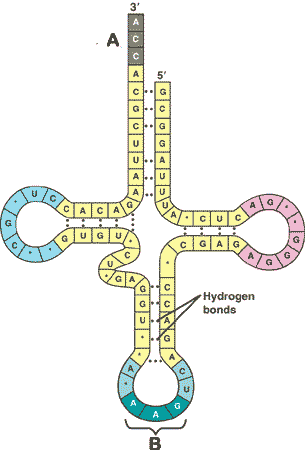| A | B |
|---|
| The process of making proteins inside cells is called ______. | protein synthesis |
| Inside which organelle is DNA located? | nucleus (Remember, prokaryotes don't have a nucleus, so their DNA is located out in the cytosol/cytoplasm) |
Which type of nucleic acid can't leave the nucleus?, 
| DNA |
| On which organelle are proteins made? | ribosomes (This is true of both prokaryotes and eukaryotes. Prokaryotic ribosomes are a little bit smaller, but otherwise very similar to the eukaryotic ribosome), 
|
| Where are ribosomes located? | out in the cytosol (Most of the time, they are free-floating. Sometimes, they attach to ER to make it rough ER), 
|
| The process of making a strand of m-RNA in the nucleus is called _____. | transcription |
Which nucleotide do you find in RNA but not DNA?, 
| uracil |
| Uracil bonds to _____ at the nitrogenous base. | adenine |
| The process of using the instructions on RNA to make a long chain of amino acids in the correct order to form a protein is called _____. | translation |
| Which type of molecule brings amino acids to the site of protein synthesis? | transfer RNA (t-RNA) |
| Which molecule attaches to a ribosome and serves as instructions for putting amino acids together? | messenger RNA (m-RNA) |
How many nucleotides are needed to code for 1 amino acid?, 
| 3 |
| How many different types of amino acids are used to make proteins? | 20 |
Each set of 3 nucleotides on a strand of m-RNA is called a(n) _____., 
| codon |
| How many nucleotides are found at the bottom of a molecule of t-RNA and are involved with bonding to m-RNA? | 3 (The part labeled B in the diagram below),  |
| How many amino acids are found attached to a molecule of t-RNA? | 1,  |
A change in the sequence of nucleotides in a molecule of DNA is called a(n) ____., 
| mutation |
| Mutations that are harmful are usually weeded out by ______. | natural selection |
| Mutations in a gene that are helpful usually become part of the gene pool as a new ____. | allele (a different form of a gene) |
Which amino acid would the codon sequence AGU call for?,  | Serine,  |
| What are three types of RNA? | m-RNA (messenger RNA), t-RNA (transfer RNA) and r-RNA (ribosomal RNA) |
| Where does transcription occur? | In the nucleus (In prokaryotes, it occurs out in the cytosol because prokaryotic organisms don't have a nucleus) |
| Where does translation occur? | Out in the cytoplasm on ribosomes. |
| Genes contain instructions for assembling ___. | proteins |
| Proteins are made out of ____. | amino acids |
The picture below is called the ____.,  | genetic code (All organisms, from prokaryotic bacteria all the way up to humans, use this same genetic code),  |
| True or False: All organisms share the same genetic code. | TRUE (All organisms will translate a strand of m-RNA into the same sequence of amino acids according to the genetic code shown below),  |